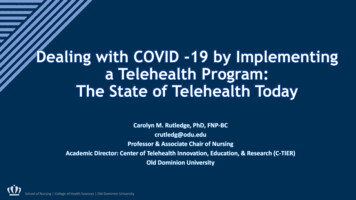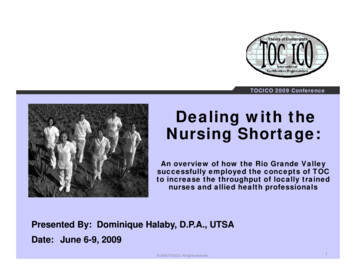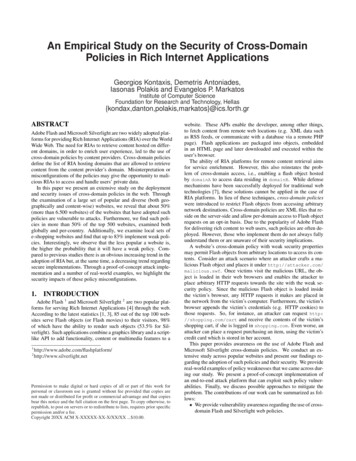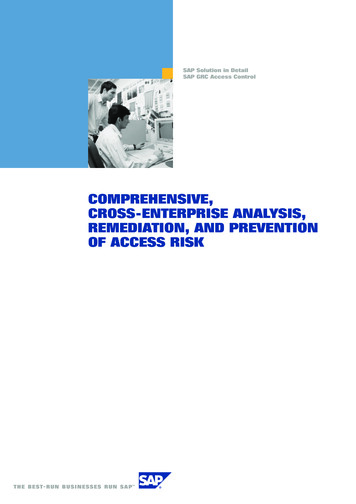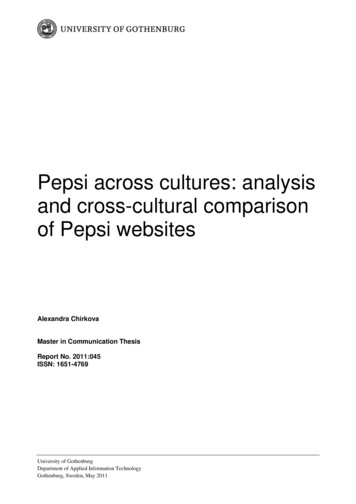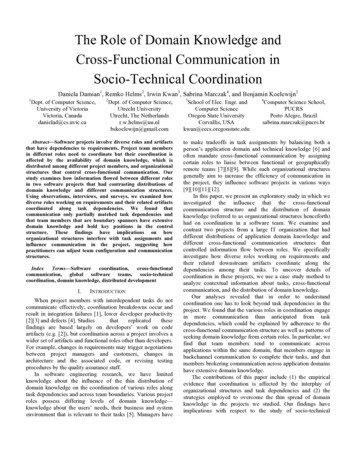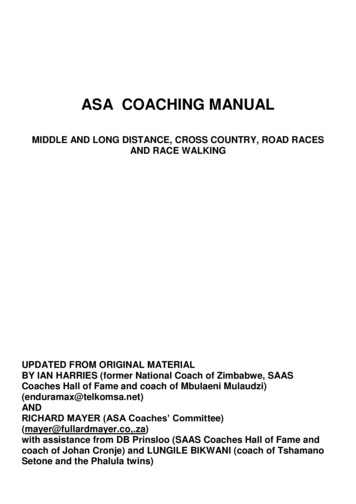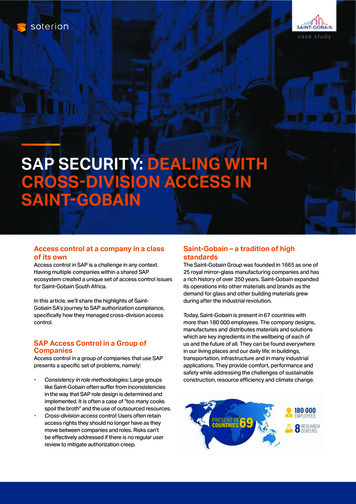
Transcription
case studySAP SECURITY: DEALING WITHCROSS-DIVISION ACCESS INSAINT-GOBAINAccess control at a company in a classof its ownSaint-Gobain – a tradition of highstandardsAccess control in SAP is a challenge in any context.Having multiple companies within a shared SAPecosystem created a unique set of access control issuesfor Saint-Gobain South Africa.The Saint-Gobain Group was founded in 1665 as one of25 royal mirror-glass manufacturing companies and hasa rich history of over 350 years. Saint-Gobain expandedits operations into other materials and brands as thedemand for glass and other building materials grewduring after the industrial revolution.In this article, we’ll share the highlights of SaintGobain SA’s journey to SAP authorization compliance,specifically how they managed cross-division accesscontrol.SAP Access Control in a Group ofCompaniesAccess control in a group of companies that use SAPpresents a specific set of problems, namely: Consistency in role methodologies: Large groupslike Saint-Gobain often suffer from inconsistenciesin the way that SAP role design is determined andimplemented. It is often a case of “too many cooksspoil the broth” and the use of outsourced resources.Cross-division access control: Users often retainaccess rights they should no longer have as theymove between companies and roles. Risks can’tbe effectively addressed if there is no regular userreview to mitigate authorization creep.Today, Saint-Gobain is present in 67 countries withmore than 180 000 employees. The company designs,manufactures and distributes materials and solutionswhich are key ingredients in the wellbeing of each ofus and the future of all. They can be found everywherein our living places and our daily life: in buildings,transportation, infrastructure and in many industrialapplications. They provide comfort, performance andsafety while addressing the challenges of sustainableconstruction, resource efficiency and climate change.
The case of the leaky Chinese wallFour divisions and surprise auditsSaint-Gobain SA consists of several business divisions.Four of the divisions (Weber, Gyproc, ISOVER and PAM)access a single SAP ECC system with a requirement torestrict cross-business activity access. An employee ofone business activity should not have access to any ofthe other business activities with this restriction in place.As part of their efforts to maintain their high standards,Saint-Gobain has a powerful group-wide internal auditdepartment. They are mandated to perform surpriseaudits on a regular basis with typically only one-monthnotice. Most of the attention in such audits is focusedon user access (specifically wide and cross-businessactivity access) due to the nature of the group.The company being audited receives a grade at theend of the audit based on one of the following processgrades:GradeDescriptionAControl in place, efficient and formalized.The risks are properly mitigated.BControl in place but not fully efficientand/or issues noted in terms offormalization. There is limited residualThe challenges of outsourcing and authorizationcreepSaint-Gobain SA initially adopted SAP in 2001 and facedseveral challenges, consistently failing their accesscontrol audits.The first challenge was the access control methodologythat was selected during the initial SAP implementation.The job-based roles were too broad and provided toomuch access to users.Typical of most companies running SAP, Saint-GobainSA also had a challenge with “authorization creep”where users inherited additional access as they movedinternally between jobs and business units within thegroup. As the user moved to a new position therewould be a handover period where they would requiretemporary access to their previous role. However, sincethere was no access risk solution to highlight these risks,access would often remain in place. This resulted in a“leaky Chinese wall” between the companiesSaint-Gobain SA made use of an SAP authorizationoutsourced provider to perform technical functions suchas role changes. Using an outsourced provider yieldedtwo unexpected challenges: risk exposure.CControl in place but incomplete. There issome remaining risk exposure.DInefficient control. There is significantremaining risk exposure.ENo control. There is ongoing high-risk The service provider operated on a basis of executingtheir approach only, and never offered any indicationof best practices. As role changes were applied,many of the risky practices became ingrained in thesystem.The outsourced provider changed security resourcesa number of times. This caused inconsistencies inrole methodologies as each resource had a preferredapproach.exposureWithout an access risk solution, there was no visibility ofthe access risk impact of the SAP access changerequest.
Taking on the GRC JourneyStrong foundations similar to a multi-storybuildingAfter evaluating a number of possible SAP accessrisk (GRC) solutions, Saint-Gobain SA selected andimplemented the Soterion solution in 2015. However,implementing an access risk solution was not the silverbullet that Saint-Gobain SA was expecting.Saint-Gobain SA were still failing audits dueto users having cross-division access eventhough an access risk solution was in place.Saint-Gobain SA was passionate about implementinggood SAP security. They realized that they needed morethan just a technical access risk solution and approachedSoterion for assistance in understanding and fixing theunderlying problems.Two critical issues were highlighted during the initialconsultation with Soterion: Saint-Gobain SA had a mix of role methodologieswhich made the assignment of appropriate roleaccess overly complicated.The risk assessment indicated many roles that hadcross-division access, creating a “leaky Chinese wall”between the different divisions.Robust access control can be compared to a multi-storybuilding. A strong foundation requires good role designfor both business and technical roles.The organization benefit from a GRC solution as soon as astrong foundation is in place.Once a solid role design and GRC principles are in place,the next level of Identity Access Management (IAM) canbe implemented, promoting and ensuring fine-grainedcontrol of access.
A GRC turnaround roadmapRole redesignIn SAP there are various approaches to role design, each with their own unique set of pros andcons. A comparison was done for Saint-Gobain SA between a derived role methodology and atask/value role methodology. The following outcome was determined based on Saint-GobainSA’s requirements:Role DesignMethodologyProsConsDerived Well-known methodology Task and Value Composite If small (functional) roles are created, youend up with many roles derived for eachOrganizational Level or controlling fieldSupport intensiveFewer roles, better visibility of user accessEasier risk remediation for superfluousrolesFine-grained or appropriate assignment ofaccess Not a well-known methodologyRequires more advanced securityadministrators to keep solution robustEasy maintenance or support Minimal flexibility, wider access (more risk)A primary requirement for Saint-Gobain SA wasto find a balance between flexibility and controlin their role design. Saint-Gobain SA decidedon creating smaller functional or task roles(e.g. Purchase Order Processing) to provide thenecessary level of flexibility.In line with the role types, the project was split as follows: The derived role methodology was rejected due to thevast number of roles that Saint-Gobain would haveended up with, based on the number of controlling fieldvalues (Company Codes or Plants, etc). Ultimately therole methodology chosen was based on “task and value”which would be applied to business and technical roles. Business End User roles: Using the User-Transactionlogs (SM20), task roles were assigned to the usersbased on historical data in combination with linemanager approval. A number of functional roles wereidentified and applied as business roles. This allowsfor ease of change if required. Organizational levelaccess was provided via value roles.Technical roles (Phase 1): Appropriate task rolesrelated to technical job functions (e.g. Basis,authorization administration, etc.) limited the risk ofwide access given to internal support personnel andoutsourced providers.Technical roles (Phase 2): Restriction of basiscritical authorization objects, with a special focuson implementing fine-grained Remote Function Call(RFC) access.
Rule-set customizationRule-sets are combined rules that are attached to identifiedGRC risks. They are implemented as a means to link mitigatingcontrols to the risks associated with business processes.Soterion developed a standard rule-set that needed to beadapted to suit Saint-Gobain SA’s needs. The Soterion solutionwas implemented with a market-leading access risk rule-set.However, as with all standard or out-of-the-box rule-sets, theyare designed to be applicable to organizations across differentindustries and geographies. Customizing the rule-set to beSaint-Gobain SA specific was an important step in the journey toensure business buy-in.As it is impossible to operate without any access risk, mitigationsplay a vital role in reducing the organization’s risk exposure. Itwas important to mitigate those risks that were unavoidable andrelevant to the organization. Many controls already existed in thebusiness. These controls were identified and documented into acentral repository, and mapped to risks in the customized ruleset.Part of the solution was educating line managers on risksand mitigating controls relevant to their area of responsibility,promoting ownership. Business unit heads were trained tounderstand what they were reviewing so that they can makeinformed business decisions, thus promoting a culture of riskawareness in the organization.In certain circumstances, business and support users requiretemporary or ad-hoc (emergency) access to perform businesscritical activities.Saint-Gobain SA implemented Soterion’s Elevated RightsManager to manage sensitive and emergency access. Thismodule ensures both support and business users have accessto sensitive functions when required in a controlled manner.Elevated Rights sessions are logged and their activity sent toowners for reviewContinuing the journey: Next steps for SaintGobain SAProper GRC management is an ongoing process. Every GRCjourney has as its goal flexible, effectively controlled user accessrights management.The next steps in the journey for Saint-Gobain SA are: User access reviews: Implementing an access request,review and approval process. Identity management: As an additional layer to provide finegrained access control, Saint-Gobain SA will consider thebusiness case for an identity access management solution.GRC as a Managed ServiceMore than outsourcingAn SAP system is constantly changing as the organizationevolves. Employees move between departments, newemployees join, and in the case of a group of companies,employees sometimes move to sister companies. User accessneeds to change with every movement of an employee, butwithout appropriate support, they often remain incorrectlyassigned. Saint-Gobain SA understand the reason for their SAPauthorization challenges prior to their GRC journey and want toensure that the solution stays in good shape. They understandthat much of the integrity of their authorization solution relieson the abilities of their outsourced provider to implement bestpractices in line with the new approach.The failures experienced with previously outsourcedproviders highlighted that they are not just wanting tooutsource authorizations. Instead, they are looking for a morecomprehensive offering: GRC as a managed service.What is GRC as a managed service?GRC as a managed service is a relationship between theservice provider and client that contributes expertise alongwith technology to fulfil certain needs. It isn’t just outsourcingtechnical activities - it is a partnership where the service providerlooks after the client as if they are part of the organization. ForSAP GRC, a managed service extends beyond standard SAPauthorizations to include risk, controls and audit support. AsSaint-Gobain SA matures on their GRC journey, their internalexpertise has allowed them to bring some of the activitiesin-house. This means that they no longer need to rely fully onthe outsourced support to perform authorizations functions.Instead, only role content changes now need to be outsourced,while the allocation of roles is handled internally. As part of thisdevelopment, Saint-Gobain SA introduced an internal controlsdepartment. This has allowed ownership to move away from ITto the business, giving process owners better insight into, andcontrol over, the risks within their domains.For Saint-Gobain SA there was a constant challenge aroundaccess control to their SAP systems. They didn’t have a clearview of their access risk and suffered from authorization creep.The problems they experienced were further compounded byoutsourced partners who performed technical functions onrequest, rather than guiding them towards best practices. In fact,with the change of every outsourced resource, different roledesign methodologies made it overly complicated to managerole access. All these issues were reflected in the results ofsurprise audits, which they often failed.After engaging with Soterion, Saint-Gobain SA was preparedfor audit success through the role redesign. With a betterunderstanding of business risks, along with a higher degreeof access control, process owners developed more businessaccountability. The Soterion solution provides business unitheads with more visibility, control and management buy-in.Governance, Risk and Compliance is a continuous journey. Withthe support of Soterion, Saint-Gobain SA has established asound basis for their authorizations and a clear roadmap ahead.Let’s talk: info@soterion.com www.soterion.com
Rule-set customization Rule-sets are combined rules that are attached to identiied GRC risks. They are implemented as a means to link mitigating controls to the risks associated with business processes. Soterion developed a standard rule-set that needed to be adapted to suit Saint-Gobain SA’s needs. The Soterion solution was implemented with a market-leading access risk rule-set. However, as .

